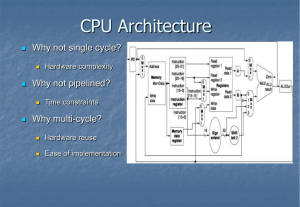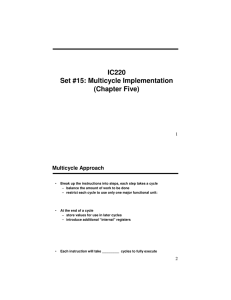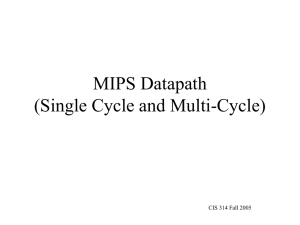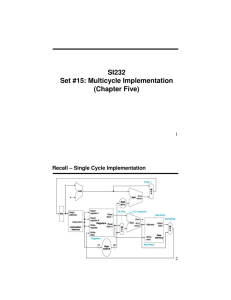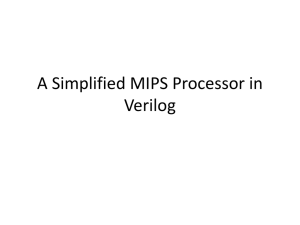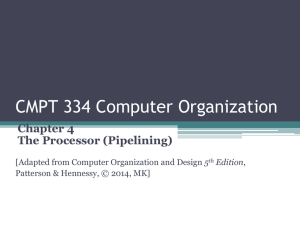L5-Multi-Cycle-CPU - Peer Instruction for Computer Science
advertisement
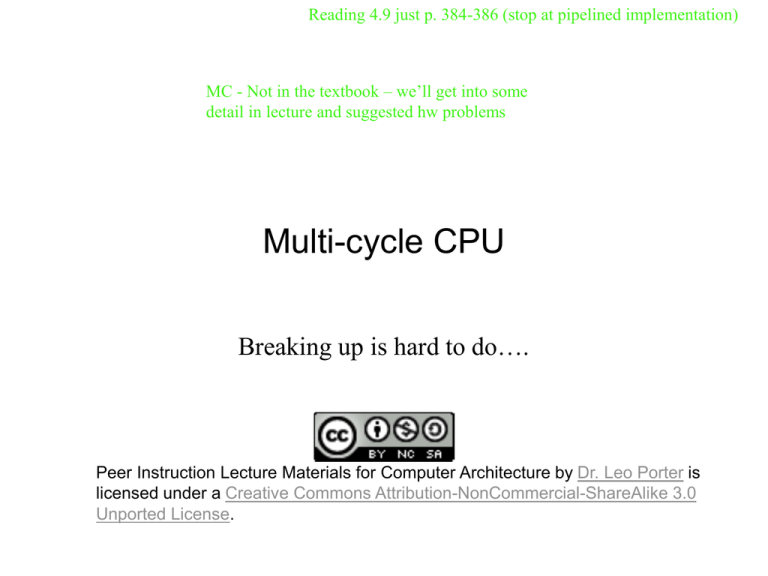
Reading 4.9 just p. 384-386 (stop at pipelined implementation) MC - Not in the textbook – we’ll get into some detail in lecture and suggested hw problems Multi-cycle CPU Breaking up is hard to do…. Peer Instruction Lecture Materials for Computer Architecture by Dr. Leo Porter is licensed under a Creative Commons Attribution-NonCommercial-ShareAlike 3.0 Unported License. Single-Cycle CPU Summary • Easy, particularly the control • Which instruction takes the longest? By how much? Why is that a problem? • ET = IC * CPI * CT • What else can we do? • When does a multi-cycle implementation make sense? – e.g., 70% of instructions take 75 ns, 30% take 200 ns? – suppose 20% overhead for extra latches • Real machines have much more variable instruction latencies than this. 200 vs. (200*.3+75*.7)*1.2 (60+50)*1.2 ~ 135 You’ve been walking through history • Someone needed to run a program You’ve been walking through history • Someone needed to run a program • Simple instructions were designed for very simple hardware (limited transistors) You’ve been walking through history • Someone needed to run a program • Simple instructions were designed for very simple • hardware (limited transistors) Someone wants to run a new program, but not create all new hardware You’ve been walking through history • Someone needed to run a program • Simple instructions were designed for very simple • • hardware (limited transistors) Someone wants to run a new program, but not create all new hardware More instructions added LAB! You’ve been walking through history • Someone needed to run a program • Simple instructions were designed for very simple • • • • hardware (limited transistors) Someone wants to run a new program, but not create all new hardware More instructions added More transistors enable more complex hardware More complex instructions are desired as instruction memory is limited and costly The story continues.. Why a Multiple Clock Cycle CPU? • the problem => single-cycle cpu has a cycle time long • • enough to complete the longest instruction in the machine the solution => break up execution into smaller tasks, each task taking a cycle, different instructions requiring different numbers of cycles or tasks other advantages => reuse of functional units (e.g., alu, memory) • ET = IC * CPI * CT Breaking Execution Into Clock Cycles • We will have five execution steps (not all instructions use all five) – – – – – fetch decode & register fetch execute memory access write-back Single Cycle vs. Multi-cycle CPI Single Cycle Multi-cycle lw sw add r-type Draw stages and how they get cutup CT Cutting up Single Cycle Draw how we’d most logically cut this up Then point out wait – if I cut the cycle time, how do I keep What I’ve done? Breaking Execution Into Clock Cycles • Introduces extra registers when: – signal is computed in one clock cycle and used in another, AND – the inputs to the functional block that outputs this signal can change before the signal is written into a state element. • Significantly complicates control. Why? • The goal is to balance the amount of work done each cycle. Multicycle datapath Intermediate latches. One ALU One memory (give hint about self-modifying code) Load word, write RTL below Multicycle datapath –per Load word cycle Talk through each – esp. the early branch computation Summary of execution steps •We can use Register-Transfer-Language (RTL) to describe these steps Step Instruction Fetch Instruction Decode/ register fetch Execution, address computation, branch completion Memory access or Rtype completion Write-back R-type Memory Branch IR = Mem[PC] PC = PC + 4 A = Reg[IR[25-21]] B = Reg[IR[20-16]] ALUout = PC + (sign-extend(IR[15-0]) << 2) ALUout = A op B ALUout = A + if (A==B) then signPC=ALUout extend(IR[15-0]) Reg[IR[15-11]] = memory-data = ALUout Mem[ALUout] or Mem[ALUout]= B Reg[IR[20-16]] = memory-data Step Instruction Fetch Instruction Decode/ register fetch Execution, address computation, branch completion Memory access or Rtype completion Write-back Selection R-type Memory Branch IR = Mem[PC] PC = PC + 4 A = Reg[IR[25-21]] B = Reg[IR[20-16]] ALUout = PC + (sign-extend(IR[15-0]) << 2) ALUout = A op B ALUout = A + if (A==B) then signPC=ALUout extend(IR[15-0]) Reg[IR[15-11]] = memory-data = ALUout Mem[ALUout] or Mem[ALUout]= B Reg[IR[20-16]] = memory-data Peer instruction Why are the first Two the same? Why are the first two stages always the same (best answer)? A All instructions do the same thing at the start B The instruction is not determined until after the 2nd cycle C To decrease the complexity of the control logic D Trick question – they aren’t always the same E None of the above Complete Multicycle Datapath (don’t be intimidated – it all makes sense…) Complete Multicycle Datapath R-type – 1st cycle Draw active path Complete Multicycle Datapath R-type – 2nd cycle Complete Multicycle Datapath R-type –3rd cycle Complete Multicycle Datapath R-type – 4th cycle Which inst. does PCWrite stuck at 1 break? A. Lw B. R-type C. Beq D. Both A & B E. A,B,&C Multicycle Control • Single-cycle control used combinational logic • Multi-cycle control uses a Finite State Machine. • FSM defines a succession of states, transitions between • states (based on inputs), and outputs (based on state) First two states same for every instruction, next state depends on opcode Breaking a single cycle processor into stages, hardware engineers determine these to be the execution time per stage. The code below is the most commonly executed code by the company. Loop: lw r1, 0 (r2) Isomorphic add r2, r3, r4 sub r5, r1, r2 beq r5, $zero IF = 200ps ID = 50ps EX = 100ps M = 200ps WB = 50ps Your boss is interested in changing to the MIPS multi-cycle processor. He asks you whether or not this would be a good idea. You say? Selection Good idea? Reason A Yes CPI stays the same. CT decreases (factor of 4) B Yes CPI increases (factor of 4). CT decreases (factor of 5) C No CPI increases (factor of 4). CT decreases (factor of 3) D No CPI decreases (factor of 5 ). CT increases (factor of 5) E No CPI stays the same. CT stays the same. Complexity increases. Breaking a single cycle processor into stages, hardware engineers determine these to be the execution time per stage. The code below is the most commonly executed code by the company. Loop: lw r1, 0 (r2) add r2, r3, r4 sub r5, r1, r2 beq r5, $zero IF = 200ps ID = 200ps EX = 200ps M = 200ps WB = 200ps Your boss is interested in changing to the MIPS multi-cycle processor. He asks you whether or not this would be a good idea. You say? Selection Good idea? Reason A Yes CPI stays the same. CT decreases (factor of 4) B Yes CPI increases (factor of 4). CT decreases (factor of 5) C No CPI increases (factor of 4). CT decreases (factor of 3) D No CPI decreases (factor of 5 ). CT increases (factor of 5) E No CPI stays the same. CT stays the same. Complexity increases. Balanced cycles explanation Draw single-cycle wasted time Draw multi-cycle potential wasted time (200,50,100,200,50) Multi-cycle Questions • How many cycles will it take to execute this code? lw $t2, 0($t3) lw $t3, 4($t3) beq $t2, $t3, Label #assume not taken add $t5, $t2, $t3 sw $t5, 8($t3) Selection Number of Label: ... Cycles A 5 B 21 C 22 D 25 E None of the above Multi-cycle Questions • What is going on in cycle 8? lw $t2, 0($t3) lw $t3, 4($t3) beq $t2, $t3, Label add $t5, $t2, $t3 sw $t5, 8($t3) Label: ... #assume not taken Selection Number of Cycles A PC=PC+4; IR=M[pc] B A=R[t3]; B=R[t3] C ALUOut=R[t3]+4 D R[t3]=M[ALUOut] E None of the above Suppose you work on an embedded multi-cycle MIPS processor and your software team tells you that every program which executes has to go through memory and zero 1k bytes of data fairly often (averages 10% of ET). You realize you could just have a single instruction do this called zero1k (rs) which does: Remember to ask about M[rs] = 0 … M[rs+1020] = 0. single-cycle Your coworker thinks you are crazy. You reply? Answer - D Selection Crazy? Reason A Yes The complexity of such an instruction combined with no performance gain is silly. B Yes The complexity of such an instruction combined with minimal performance gain (<5%) is silly. C No The minimal performance gains (<5%) rationalize this simple instruction. D No The significant performance gains (>5%) rationalize this complex instruction. E Maybe None of the above. Show code, then cycle analysis. Finite State Machine for Control • Implementation: • ROM = "Read Only Memory" ROM Implementation – values of memory locations are fixed ahead of time • A ROM can be used to implement a truth table – if the address is m-bits, we can address 2m entries in the ROM. – our outputs are the bits of data that the address points to. m n 2m is the "height", and n is the "width" 0 1 0 0 0 0 0 0 1 0 1 0 0 1 0 0 1 0 1 0 0 0 0 1 0 0 0 1 1 1 0 1 1 1 1 0 0 0 0 1 0 0 ROM Implementation • How many inputs are there? • 6 bits for opcode, 4 bits for state = 10 address lines (i.e., 210 = 1024 different addresses) How many outputs are there? 16 datapath-control outputs, 4 state bits = 20 outputs • ROM is 210 x 20 = 20K bits (and a rather unusual size) • Rather wasteful, since for lots of the entries, the outputs are the same — i.e., opcode is often ignored Multicycle CPU Key Points • Performance gain achieved from variable-length • • • • instructions ET = IC * CPI * cycle time Required very few new state elements More, and more complex, control signals Control requires FSM
